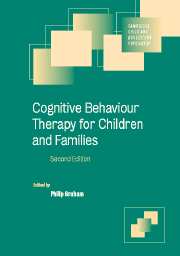Book contents
- Frontmatter
- Contents
- List of contributors
- 1 Introduction
- Part I Developmental cognitive theory and clinical practice
- Part II Engagement and assessment
- Part III Client groups
- Part IV Applications in psychosocial adversity
- Part V Applications in specific child and adolescent psychiatric disorders
- 12 Behavioural approaches to eating and sleeping problems in young children
- 13 Conduct disorders in young children
- 14 Attention deficit hyperactivity disorder
- 15 Children with developmental disabilities and their parents
- 16 Depressive disorders
- 17 Cognitive behavioural psychotherapy for obsessive compulsive disorders
- 18 Anxiety disorders
- 19 School refusal
- 20 Post-traumatic stress disorders
- 21 Disorders of eating control
- 22 Chronic fatigue syndrome
- 23 Children's interpersonal problems
- 24 Pain in childhood
- 25 Conduct disorders in adolescence
- 26 Drug and alcohol abuse
- Part VI CBT applications in preventive interventions
- Index
- References
21 - Disorders of eating control
Published online by Cambridge University Press: 21 August 2009
- Frontmatter
- Contents
- List of contributors
- 1 Introduction
- Part I Developmental cognitive theory and clinical practice
- Part II Engagement and assessment
- Part III Client groups
- Part IV Applications in psychosocial adversity
- Part V Applications in specific child and adolescent psychiatric disorders
- 12 Behavioural approaches to eating and sleeping problems in young children
- 13 Conduct disorders in young children
- 14 Attention deficit hyperactivity disorder
- 15 Children with developmental disabilities and their parents
- 16 Depressive disorders
- 17 Cognitive behavioural psychotherapy for obsessive compulsive disorders
- 18 Anxiety disorders
- 19 School refusal
- 20 Post-traumatic stress disorders
- 21 Disorders of eating control
- 22 Chronic fatigue syndrome
- 23 Children's interpersonal problems
- 24 Pain in childhood
- 25 Conduct disorders in adolescence
- 26 Drug and alcohol abuse
- Part VI CBT applications in preventive interventions
- Index
- References
Summary
Introduction
Eating disorders are common in teenage girls, with prevalence rates for anorexia nervosa and bulimia nervosa being 0.3%–0.6% and approximately 1%, respectively (Fairburn and Beglin, 1990; Whitaker et al., 1990; Rathner and Messner, 1993; Van Hoeken et al., 1998). Disorders of eating control not reaching diagnostic criteria are considerably more common (Childress et al., 1993). Many adolescents have negative cognitions about their shape and weight, commonly leading to dieting as a way of improving self-image (Killen et al., 1994; Smolak and Levine, 1994). Dieting is an established risk factor for eating disorders (Patton et al., 1990) and, for those adolescents who go on to develop an eating disorder, negative cognitions may become established. Even those who regain their weight may continue to hold negative cognitions about their body and, therefore, are vulnerable to further weight loss (Fairburn et al., 1993a). Low self-esteem is frequently present in adolescents who develop these difficulties (Button et al., 1996). Cognitive behaviour therapy (CBT) can provide a useful therapeutic approach to address negative cognitions about shape and weight and underlying core beliefs as well as promoting behavioural change (Garner et al., 1997; Wilson et al., 1997). However, the models developed for adults require adaptation for use with adolescents (Lock, 2002).
This chapter explores the use of CBT in adolescents with eating disorders, focusing on anorexia nervosa and bulimia nervosa. First, the diagnostic and clinical features of these disorders will be described, followed by the research basis for the use of CBT.
- Type
- Chapter
- Information
- Cognitive Behaviour Therapy for Children and Families , pp. 359 - 384Publisher: Cambridge University PressPrint publication year: 2004



